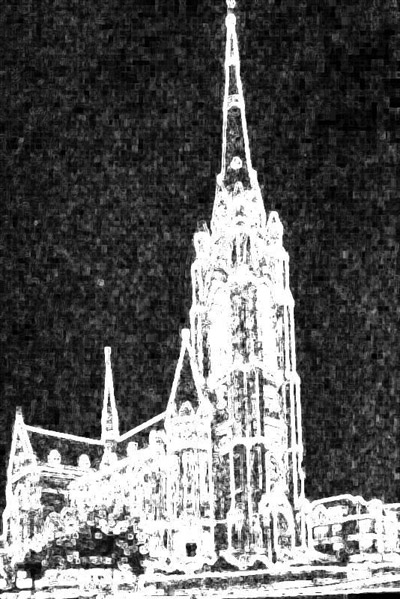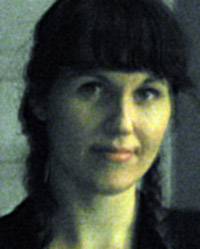
| Jacket 36 — Late 2008 | Jacket 36 Contents page | Jacket Homepage | Search Jacket |
This piece is about 6 printed pages long.
It is copyright © Lisa Donovan and Jacket magazine 2009. See our [»»] Copyright notice.
The Internet address of this page is http://jacketmagazine.com/36/guest-donovan.shtml
Section 1
The word is tested by time, is interrogated by memory. The poem is an article, is a body positioned in space. As readers we need a locatable hand welcoming us out of the madness. From this outside position we look in at the sometimes terrifying structure of life; and through this outside lens we see that the structure, so terrifying from within, falls to pieces, to shambles without us. For Barbara Guest, the poem is related through a type of invisible architecture, held in balance from an outside force, a willed existence. And for Guest, the poem is echoed out of history, from a space outside our comprehension, a subtle lingering of the past, a thought towards the future. In her work we experience the breaking down, the necessary falling apart of a tradition laid bare and crumbling. The lyric poem, within her time, begged a change but asked that it not be forgotten. Guest took on the challenge of change but was not so foolish as to forget that, as she grew into her own individual poet, she was held by firm roots.
2
In her short essay “Invisible Architecture” Guest relates how the poem, just about to be born, conceives of “an invisible architecture [that] upholds the poem while allowing a moment of relaxation for the unconscious“ (Forces of Imagination 18); and this trace of architecture brings to mind the remnants of a past structure — a ruin. In my mind it makes good sense to consider this invisibility of which she speaks as representing the ghost of a familiar past: that of a history of lyrical poetry. Discovering her own way, clambering among the muck of the past, Guest was able to move forward but not without those trace projections.
3
A ruin is a familiar past but exists only slightly within the realms of our own consciousness, our own existence. The power of a ruin is that it lies outside necessity and is economically barren, but it is a place for the imagination to thrive in. Consider when she says “ the unstableness of the poem is important” or when she lends, the loss of “arrogance of dominion over the poem [is] to an invisible hand”. The ruin has no author, and its fragile structure lends itself to the transcendent: it is only so blissfully here and so easily gone.
4
The bits of text of Guest’s later poems act as ruins or as remnants of an established tradition in the midst of decay. Let me explain this idea by first presenting a definition of ruin which I find appropriate: “Ruins are models or heralds of the disintegrating mind [and here I would imply the collective] and collapsing principles of the age after the end of stable belief, […] the ghost of faith” (Harbison 99). For Guest, poetry could no longer reside within the formal constructs of tradition or even of those emerging constructs created by her own contemporaries. Her work desired a new way of being and hence she allowed its collapse, to become the ghost.
5
In Guest’s poetry is the spiritual ramifications of that act, which echo and are emitted from the poems’ surface. As readers we sense the trail of the structure so soon gone, and in the fragmented remains we are allowed to imagine and to wander:
6
south dusk and fire balls—
the same at Nauplia. mythic potency—
winding down the tower—
farewell. farewells.
(Guest Farewell Stairway 236)
7
We are beckoned to leave our world, to find that hollow place in the woods or far off foreign cliff, where the wreck of a once glorious structure teeters on its foundation. As readers we come to a place always known to the mind; the place where we ventured as children, to a place of imagination where words:
8
placed dressing gowns as rosemary entered their scent
percipient as elder branches in the night where words
gathered, warped, then straightened, making new wands.
(Guest Words 237)
9
We are invited to be careful while we step through this place, always new, but to know that magic is our making in this place protected by the branching out arms of trees. And not just any trees but “bone trees” where “no moral is drawn from the assemblage” as opposed to the conservative trees whose value is the “absoluteness of growing things” (Guest) much like the bound and propped whisper of trees surrounding most public parks — controlled public space.
10
under the rough mountain
tree growth out of rock.
a natural tone in the poems.
lid pried open volumes fall out — (Guest Chalk 287)
11
Primary to the experience of reading Guest’s poetry is the use of space. And this is not always a visual phenomenon. Although the majority of her poems do engage space primarily on a visual plane, the poems where this is not necessarily the case still relate space through either diction or image. In either instance the experience is not so much that of a void but rather something defined, something that holds the trace of a willed hand. Although a rather stark image, it is somewhat similar to stepping from a cliff, as we tumble down inside the space, we realize the face of the cliffs assist in outlining the area in which we fall. The space is a negation, the absence of the text, where we are held at a loss.
12
But the space is not simply the opposite or even the completion of a ritualistic decay as I have said about the text. What I believe happens within the confines of this space is a worked-up-to absence. Another way to think about this is to use the example of the shell (Bachelard). The shell, when we come upon it, is known to us to be the former home to a living organism; a creature, as he notes, “that hides and withdraws into its shell, [… ] preparing a way out” (p. 111). The shell, no longer holding the organism within the carefully constructed and personalized space, harbors a type of loss; the loss of usefulness, and the loss of its creating a particular type of living space. The space of a shell is then a negation and unlike a ruin, the existing structure is similar to that of real bone — hard and not easily weathered. The shell, like the space in Guest’s poems, is especially architected to harbor the body at first, but eventually is composed of pure space we then find imbued with a highly particular type of magic.
13
the plots of sandust.
“the thing that was dear”
scenes with table.
an intense
idolizing. frame with multiple rose. (Guest Dove 263)
14
The experience is as if “space, with its faintest traces of a highly specific architecture relates a form that is more intelligible for the eye, even though more mysterious for the mind” (Valery cited by Bachelard 106). Guest’s space is at once built up of the unbuildable, we see the space and are comforted by our visual recognition, but we have a sensory experience of the opposite, of absence.
15
the globular
solitude
invisible swell (Guest Paulownia 263)
16
Guest acknowledges the medieval world as a resource and inspiration in her work, and it seems appropriate to use the Gothic as a way of pulling together both of my previous ideas regarding architecture. The fantastic thing about Gothic architecture is that, as a form, it can be seen as a bold representation of ruin; like a ruin it is bare, its bones seems more like remnants of a complete structure rather than the primary building parts of a real architected body; and like a ruin, it seems so blissfully here, and so near to obliteration. It owns a type of fragility.

17
Another consideration when looking at a piece of Gothic architecture is the space created around it, how it harmonizes or feels disjunctive with the surrounding natural world, and how the never-ending space that is the sky is highlighted by its everlasting and mathematically precise spires. The Gothic structure can also be seen as acting as an architected negation; emphasizing the heavens, acting as a photographic negative of the sky, or to take it a bit further, as if “something solid is being removed from its natural surrounding by something incorporeal, divested of weight and made to soar upwards” (Jantzen cited in Art of Gothic 7).
18
near an ancient site of accord
and priority
In no climate whatsoever
noise traveling up the tower (Symbiosis 454)
19
Like the Gothic architects, Guest created a carefully constructed form with very little materials. The effect is a notion of a complete body that verges on transcendence and relies on trace outline, space, light and an echo of the familiar. Like the Gothic she at once formulates a structure by erecting dissolving walls.
20
So what was Guest simultaneously building up and breaking down? What was the overall effect of the challenges she posed for herself? Is it possible that within the frame of her poems there was an exclusive desire for utter obliteration? Is it fair to see Guest as sailing her ship out into the center of an ocean where she is realistically here, although isolate, distant while still being present? Her work, built while also being negated, resisting temporality but still limited by time, just rests on the cusp of an external space all the while creating an echo of internal/emotional affect. I am comfortable acknowledging the paradox of her work and see all that she wrote as entirely necessary to emitting light on a societal need for a space transcending of this one. I can also visualize Guest’s ship within sight of my own, for it is without these excursions that “dreams dry up, espionage takes the place of adventure and the police take the place of pirates.” (Foucault)
Art of Gothic Architecture, Sculpture, Painting. Köln: Könemann, 1999.
Bachelard, Gaston. Poetics of Space. Boston: Beacon Press, 1994.
Frank, Ellen Eve. Literary Architecture: Essays Toward a Tradition : Walter Pater, Gerard Manley Hopkins, Marcel Proust, Henry James. Berkeley: University of California Press, 1979.
Guest, Barbara. Collected Poems of Barbara Guest. Middletown, Conn: Wesleyan UP, 2008.
Guest, Barbara. Forces of Imagination: Writing on Writing. Berkeley, Calif: Kelsey Street Press, Distributed by Small Press Distribution, 2003.
Michel Foucault, “Of Other Spaces” (1967), Heterotopias.” Michel Foucault, info. 26 Apr. 2009 http://foucault.info/documents/heteroTopia/foucault.heterotopia.en.html
Robert, Harbison. The Built, the Unbuilt, and the Unbuildable: In Pursuit of Architectural Meaning. Cambridge, Mass: MIT Press, 1991.

Lisa Donovan
Lisa Donovan is a graduate student in the Literary Arts program at Brown University.